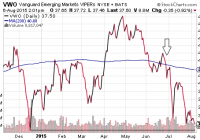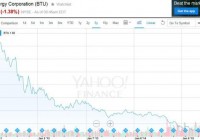XLE: Energy Stocks Still Overvalued Relative To The Oil Price
Oil may find a bottom this fall at $35-$40 — but that doesn’t mean oil stocks will find a bottom. The XLE energy stock ETF remains highly inflated, as compared with the oil price. Oil and the broader stock market have been trading together since volatility spiked in August. If the S&P 500 goes down another leg to the 1680 range this fall, XLE will fall even farther than the S&P and the oil price will. Don’t buy oil stocks yet — in fact, consider shorting XLE. Ever since the oil price crashed in the fall of 2014, investors have been trying to call a bottom and find an opportunity to invest in the energy sector at bargain values. But so far, the market has frustrated would-be value investors in energy, as the oil price and energy stocks of all types have continued to fall farther and farther. The low to date was reached in the market selloff of August 24-25, when WTIC oil settled at $38.22 and the Energy Select Sector SPDR ETF (NYSEARCA: XLE ) fell to $59.22. Some investors are now hopeful that these prices were the bottom that they have been waiting for, and they think now is finally the time to buy energy stocks and make big profits on the oil price rebound in the coming years. I believe they are half right, but unfortunately it is not the most profitable half. The oil price itself was probably very close to the bottom when it fell into the $37-$40 range for a few days, below $40 for the first time since February 2009. But the large-cap and mid-cap energy stocks in XLE probably have a lot farther to fall. XLE was in the low $40s in February 2009, and it could fall another 33% from its current price before it reaches that level again. The point is that large-cap and mid-cap energy stock prices are influenced both by the oil price and by the performance of the broader stock market in general. Their prices were very low in February 2009 because the oil price and all stock prices were very low. Their prices held up relatively quite well from fall 2014 through spring 2015 because the whole stock market was holding up well then. Investors had confidence that the big oil companies would ride out the oil price drop and continue to prosper along with the entire economy when oil prices recovered. But since the return of volatility in all markets since August, oil stocks no longer have the assurance of the broader market to fall back on. Stocks have dropped decisively from their highs earlier in 2015, and the technical charts point to further declines coming this fall, which of course is a historically weak seasonal period for stocks. Numerous technical indicators signal that if the S&P 500 cannot hold support in the 1820-1867 range, a drop all the way to 1680 is the next likely step down. Moreover, in the current period of volatility, stocks and oil are trading together. When one goes down, so does the other. A bearish market trend and linkage of stocks and oil is very, very bad news for the energy stocks in XLE. One chart shows clearly how much more room XLE has to fall: (click to enlarge) This chart shows the ratio of the share price of XLE to the actual price of WTIC oil, over the entire history of XLE as an ETF, from 1999 to the present. Notice how elevated the XLE price remains today, as compared with the oil price. The ratio has retreated from its all-time highs earlier this year, but it still remains very high compared to most of the past decade and a half. If the broader stock market takes another turn for the worse, this charts shows that XLE has plenty of room to fall along with it, even after the oil price itself nears a bottom and stops falling so steeply. Notice in the chart that until last year, the XLE:$WTIC ratio normally stayed in a range from 0.6 to 0.8. With all stocks in a downward trend, there is no particular reason to expect that XLE will stay elevated above that range, and every reason to expect the likelihood of XLE returning to that range. For example, if the oil price settles at $40 and the XLE:WTIC ratio even returns to the top of the old range at 0.8, that would mean an XLE share price of $32, almost a 50% drop from its current price. If the oil price settles at $35 and the ratio falls to the bottom of the old range at 0.6, that would mean an XLE share price of $21, a 66% drop from its current price. I am not predicting that XLE will crash to $21 or even $32 this fall. I am just pointing out that it is well within the realm of reasonable possibility and would not represent an extreme change in the historical performance of XLE relative to the oil price. More likely is a decline to the low $40s or high $30s this fall, the range that XLE fell to in the crash of 2008-2009. The overall stock market would not have to crash 2008-style for XLE energy stocks to fall to those levels. The process will look very different because in 2008, stocks crashed first and then the oil price dropped, whereas this time the oil price dropped first and stocks are falling later. Actions to take: First of all, don’t buy oil stocks yet! The knife is still falling. More aggressive investors can consider shorting XLE. As a hedge, investors can short XLE and buy The United States Oil ETF, LP ( USO) to play a decline in the XLE:$WTIC ratio.

